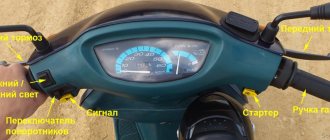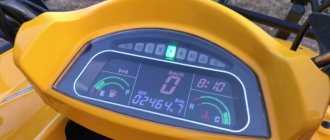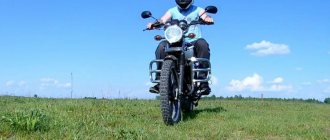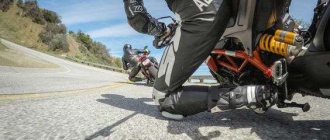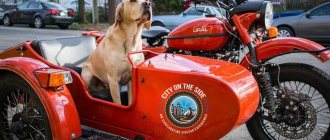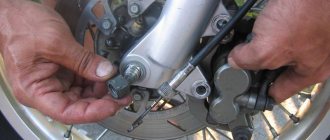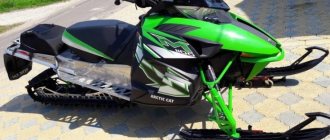Even if you are a good rider, riding with a passenger requires additional skills and knowledge. This is not only about issues related to motorcycle driving technique, but also about the comfort of your passenger. You should also remember that the person who joins you trusts you completely. You bear full responsibility for this person. It's worth remembering.
The tips below are divided into two sections. The first is for motorcyclists, and the second is for... the passenger, who should also be aware of a few basic rules.
Tips for motorcyclists
*Adjust the motorcycle's rear suspension to accommodate the additional load (see your motorcycle manual).
*Always ensure that the passenger has suitable clothing. We are talking about the basics, the minimum: boots, long trousers, a jacket or sweatshirt (they should not be loose or bulky), gloves, of course, a helmet. If you have extra knee and elbow pads, add them to your backpack.
* Make the passenger become familiar with the motorcycle: where to put their feet, what to hold on to. Remember that you know your motorcycle as you know it, but to an outsider it is a mess of cables and metal. Explain that breathing deeply while riding and spreading your arms from side to side is not a good idea - seriously, it's worth mentioning.
* The clutch problem is a priority for obvious reasons. You don't want to lose your passenger, do you? Will the passenger put his arm around your waist, or hold on to the rear handle of the motorcycle? You must explain this before traveling. And forget about the leather strap that some motorcycle daybeds have - it's just a stylish addition, you can't trust it with anyone's safety.
* If this is the “backpack”’s first ride on a motorcycle, make sure he understands two simple things: only you put your feet down during forced stops (traffic lights, stops). The passenger's feet must be on the footrests at all times. Horny "motorcycle virgins" sometimes do things that can get them into trouble.
* Develop a simple communication system regarding the need to stop and other situations such as slowing down or speeding up. There are many combinations and at the same time using sign language is fun.
* Anticipate and think. Your motorcycle will behave differently. Control may be more complex, the overall weight changes, the center of gravity shifts. It's like riding a different motorcycle. When you get on a new car, you don't unscrew the levers and fly around like crazy, right? Also note that braking performance will be reduced. Just be careful.
* While basic advice is easy to give, no one can teach you how to ride with a passenger in a few sentences. It's a matter of practice: accelerating, decelerating, braking, cornering. The passenger must be able to maintain a neutral position.
* Considering your experience and passenger needs, plan your stops in advance. You should establish that you will stop after a quarter or half an hour, this will allow your small team to breathe, relax and feel like moving on. In addition, if you see that the "backpack" is gray, like moon dust, you already know that the next stop should be earlier. Therefore, stops are also used to assess the passenger's condition, drink water and catch their breath.
* Finally, one piece of advice from personal experience. If intimacy allows, show the passenger your approval. It's a light pat on the thigh and maybe a quick thumbs up.
Comfortable and safe motorcycle riding position
It just so happens that cars are much more convenient to drive than motorcycles - in a four-wheeled vehicle, you just need to sit down in the seat and spend a few seconds finding the ideal position, so as not to return to the problem of landing in the future. But the motorcyclist must constantly monitor himself, since not only comfort, but also his safety depends on his seating position. This is especially true for sportbike owners who constantly travel at high speed. Therefore, every owner of a two-wheeler needs to know what the correct position on a motorcycle is. It depends on many factors, including the quality of the road surface, maneuvering and the type of motorcycle used - you can learn about all this from the article.
Tips for the passenger
* Since I am also sometimes a passenger myself, it is worth raising one point. Do you trust the driver? The point is not that this is your uncle, dad or school friend with whom you drank vodka. The point is, do you trust this person as a motorcyclist? When in doubt, consider whether it is worth risking your life. This is not an exaggeration, this is your life, because a motorcycle is a dangerous toy. Unfortunately, there are many boys in the world who do not know how to use it correctly.
*Have you noticed how often motorcycle accidents are reported where the passenger's helmet comes off? People unfamiliar with helmets don't know how to strap them on. If you are such a person, take a simple test. Secure the strap under your chin, then grab the back of the helmet and simultaneously pull forward and upward toward your chin. If you can remove it, the helmet is loose or does not fit properly.
* If you have high boots with laces, make sure the laces are pulled tight and preferably make two knots. You certainly don't want them to come loose while riding and end up in your rear wheel...
* Gloves should be leather, your size, and fit tightly around your wrists. It's not about being pretty, it's about protecting you in case of an accident. The person reflexively protects his head and supports his arms. This is why it is so important that your gloves are snug and form-fitting.
* Are you going to ride a motorcycle with someone? This is great, the experience will definitely be unforgettable, but how long will you be a “backpacker”? How many hours on the road, how many times will you stop, what roads will you travel on? Are you planning to drive through the city, or maybe just the highway? Keep in mind that even on hot days, the rush of air cools the body. This is why attire and frequent stops are important. Make sure the rider is aware of your needs and take care of the correct equipment.
* Learn how to sit on a motorcycle, where to place your feet, what not to touch under any circumstances, how to communicate on the road - because you almost certainly will not be able to talk.
* The passenger must not disturb the motorcycle driver. Beginning “backpacks” tend to verticalize the figure. This is mistake. The passenger should not oppose the movement of the motorcyclist's body; this is especially dangerous when cornering. Try to stay close to the driver, duplicate his moves and everything will be fine.
* Never place your feet on the ground - during a temporary stop at a traffic light or in other circumstances, unless the motorcycle driver asks you to do so.
* Don't panic if you hear a loud noise around the motorcycle's chassis. This effect mainly appears when turning.
* Learn to relax while driving and enjoy it. The art of riding as a passenger is also about letting go of the car and the driver.
* If you are uncomfortable, cold, not feeling well, something is wrong, you must inform the rider. Use the symbol system you have chosen to stop and explain what is happening. Never try to solve a problem while driving.
* Finally. Always remember that you are a passenger, even if you have experience riding a motorcycle. It's a bit like an airplane where there are two pilots, but there is only one captain. The worst thing that can happen to a motorcyclist is a passenger who wants to "help" him because he knows better. Remember, you are sitting in the back, you are a backpack, even if your name is Valentino Rossi.
It's worth remembering these tips. These are the simple things that usually slip through the cracks when two people spontaneously decide to travel together. That's why it's good to remember the tips before getting on a motorcycle together. Riding together is a fantastic experience, and anyone who has carried a woman on their steel horse knows how much fun it is. Just don't let emotions replace reason. This last tip also applies to “backpacks”. See you on the roads!
Post Views: 2,406
Hand position
Regardless of the type of motorcycle, the rider must maintain the same hand position to ensure comfortable control. They should be bent at the elbows and also relaxed. You cannot lean your hands on the steering wheel, transferring part of your weight to it - by doing this you interfere with the operation of the front suspension, and also impair controllability, since the sensitivity will be less with significant tension. A proper riding position should keep your elbows as close to the tank as possible to improve aerodynamics and prevent injury during tight turns. Extended elbows are a sign of excessive tension - if you perform a dangerous maneuver or if there is a danger of falling, this will lead to the inability to maintain control of the motorcycle.
The shoulders must be tilted forward and relaxed so that the landing does not create difficulties in controlling two-wheeled vehicles. The position of the body with raised or widely spread shoulders would be completely incorrect. The significant muscle tension that occurs in this case will also not lead to anything good.
Classic fit
The most basic view when traveling. It is suitable for standard units, such as Soviet motorcycles. A special feature of this type is its straight back. This position is ensured by foot mounts located close to the rear wheel. Weight application points are located on the seat and footrests.
With this position it is most convenient to ride bikes with low power and low speed. Due to the convenience of transferring body weight, the unit easily responds to changes in movement, and the driver, sitting upright, gets less tired.
Simple rules
Despite the seeming difficulty of choosing the right fit, you can get used to it after just a few days. However, in a critical situation, most motorcyclists still get confused, trying to choose the correct body position intuitively, which usually leads to loss of control. Therefore, beginners are advised to monitor the landing, checking whether the position of the arms and legs is correct, as well as the tilt of the body. Long-term training will help you act correctly in emergency situations, protecting yourself from the unpleasant consequences of loss of control.
Changing your seat position while riding a motorcycle
— Does it bother you when your partner fidgets in the seat? And when she does this at high speed?
Your motorcycle applies the same to you, because your movements greatly affect the behavior of the vehicle. The motorcycle is forced to constantly stabilize all your movements. The pilot usually moves forward or backward in the seat; if we are talking about a civilian driver, everyone knows about hanging down on the track.
The best way to move around in the seat is with your feet on the footrests. Beginners often do this: they leave their feet on the footrests and fidget with their pelvis. The legs at this moment seem to be out of business, but in vain! To ride a motorcycle safely, you should stand up on your feet, leaning on the pegs.
Shifting your weight helps in emergency situations such as wobbing for example. When spinning the rear wheel and wobbling, the rider can sit up on the footpegs, so the weight will be slightly lower than usual, and vibrations will not be transmitted through the body to the rear of the motorcycle. All due to a change in the fulcrum. Previously, your weight acted on the motorcycle through your pelvis, which is why the overall balance was located in one place, but as soon as you stood on the pegs, the point of support and application of the weight changed, the center of gravity changed its location.
In emergency situations, if you're picking up speed in the city and the road suddenly no longer resembles adequate surfaces and turns into a minefield of craters, the method of sitting up on the running boards acts as additional shock absorption. Thus, your own weight does not prevent the motorcycle from coping with uneven surfaces.
Correct sitting position on a motorcycle
Proper riding position on a motorcycle is one of the most important features of traction. By following the basic rules, you will have a better feel for how the bike moves. This will lead to increased control over management. During your trip you should:
- Be in constant contact with the motorcycle. Under any circumstances, do not let go of the steering wheel and press tightly against the gas tank body. You need to sit as close to the fuel tank as possible and press it with your knees. A tense state will help you respond to even the smallest changes in behavior. When accelerating, press against the gas tank, when braking, press it with your feet. When turning, lean towards the direction of the turn.
- Relax your hands. Excessive tension in the elbow joints interferes with steering control. If you lose connection with the bike, do not rest your hands on the handlebars, this will only make the situation worse. Bend your elbows, this will increase sensitivity to control.
- Lean as close to the fuel tank as possible. The body frame is the counterweight to the motorcycle. Therefore, when bumping over a bump, you can lose your balance if your body is not pressed against the motorcycle.
In cases where the legs are not pressed against the body of the bike, the main load goes to the arms and the control becomes heavy and unresponsive. In such situations, it is difficult to correctly distribute control efforts.
Leg position
It should be remembered that in all motorcycles, except choppers, the plastic lining of the tank is designed so that the driver can wrap his legs around it, increasing the stability of his position in the saddle. Your legs should not be spread even when moving in a straight line - otherwise a strong shake could knock you out of the saddle. In addition, if you do not tighten your legs, the motorcyclist will instinctively assume an incorrect position with his torso tilted back - as a result, during acceleration he will deviate even more from the steering wheel, losing control.
Many beginners who ride a sports bike for the first time also try to ride a corner in a sideways position. In this position, most of the motorcyclist's body is shifted inside the turning arc, which makes it easier to tilt the motorcycle body, but seriously impairs the stability of the two-wheeled vehicle. To understand how to sit correctly in such a case, you need to watch recordings from sports competitions - motorcyclists press their legs as tightly as possible to the gas tank, maintain the same body position, but slightly raise their shoulders to maintain full control over the technique.
Sporty fit
The design of sports bikes does not allow riding them with a straight body position. The steering wheel is located far from the seat and slightly below the gas tank. Therefore, during the trip the driver practically lies on the body of the motorcycle. The riding position on a sports motorcycle improves aerodynamics during the ride, as sports units move at very high speeds and are used in competitions. The high position of the footpegs allows the bike to lean very low when cornering at high speed.
Chopper landing
The most comfortable position in the saddle. A high steering wheel and a soft seat create maximum driving comfort. The far position of the footrests allows you to stretch your legs and feel like you are in a leather chair at home. However, there are also disadvantages. The chopper's steering wheel creates a large amplitude when cornering, and you won't be able to lean on the pegs.
Such devices are designed for quiet movement in urban environments or on the highway. Moreover, every bump is strongly reflected in the back, since the shock absorbers are located directly under the seat.
These are the main types of planting, their features and disadvantages. Based on this, you can choose the most suitable bike for yourself.
